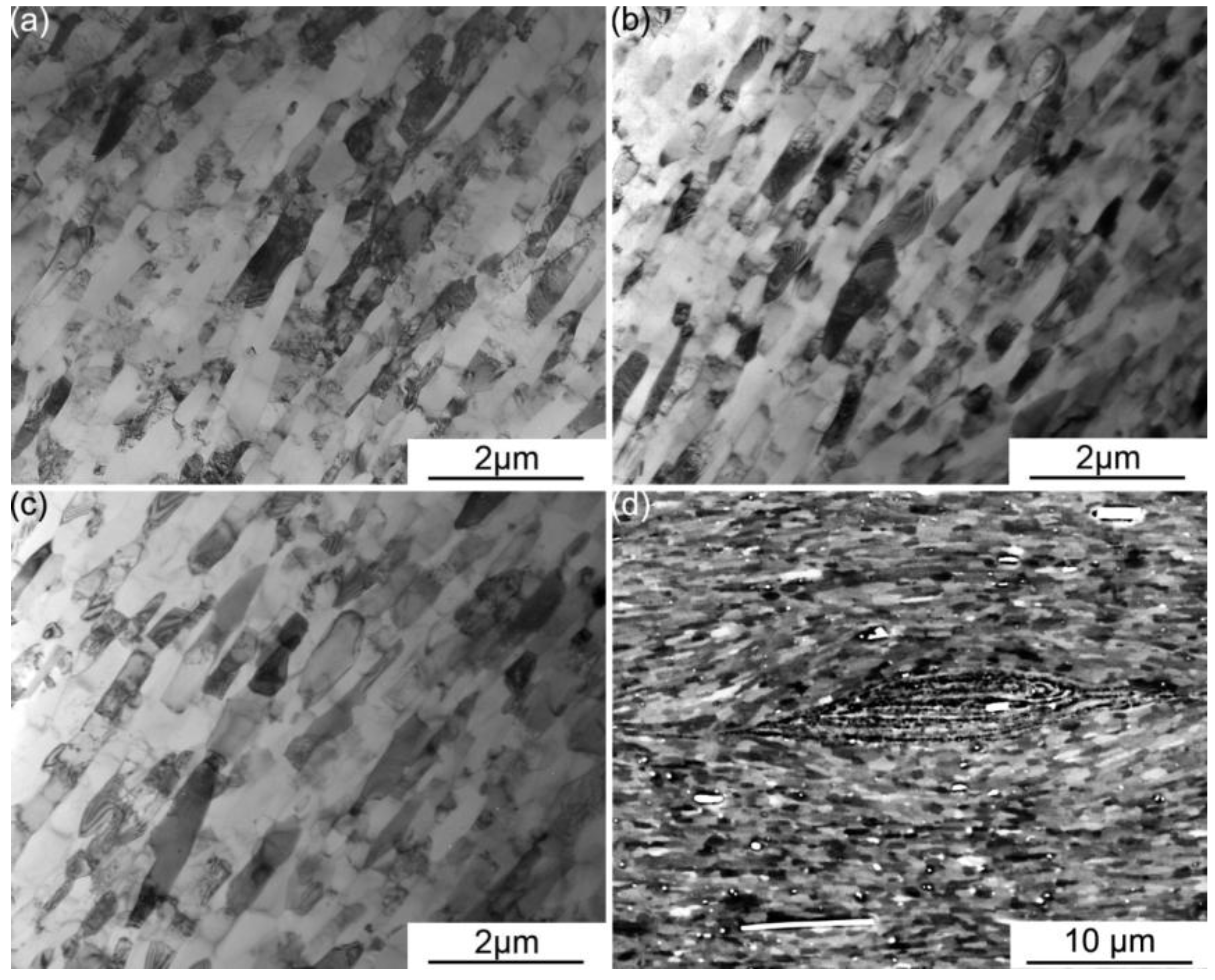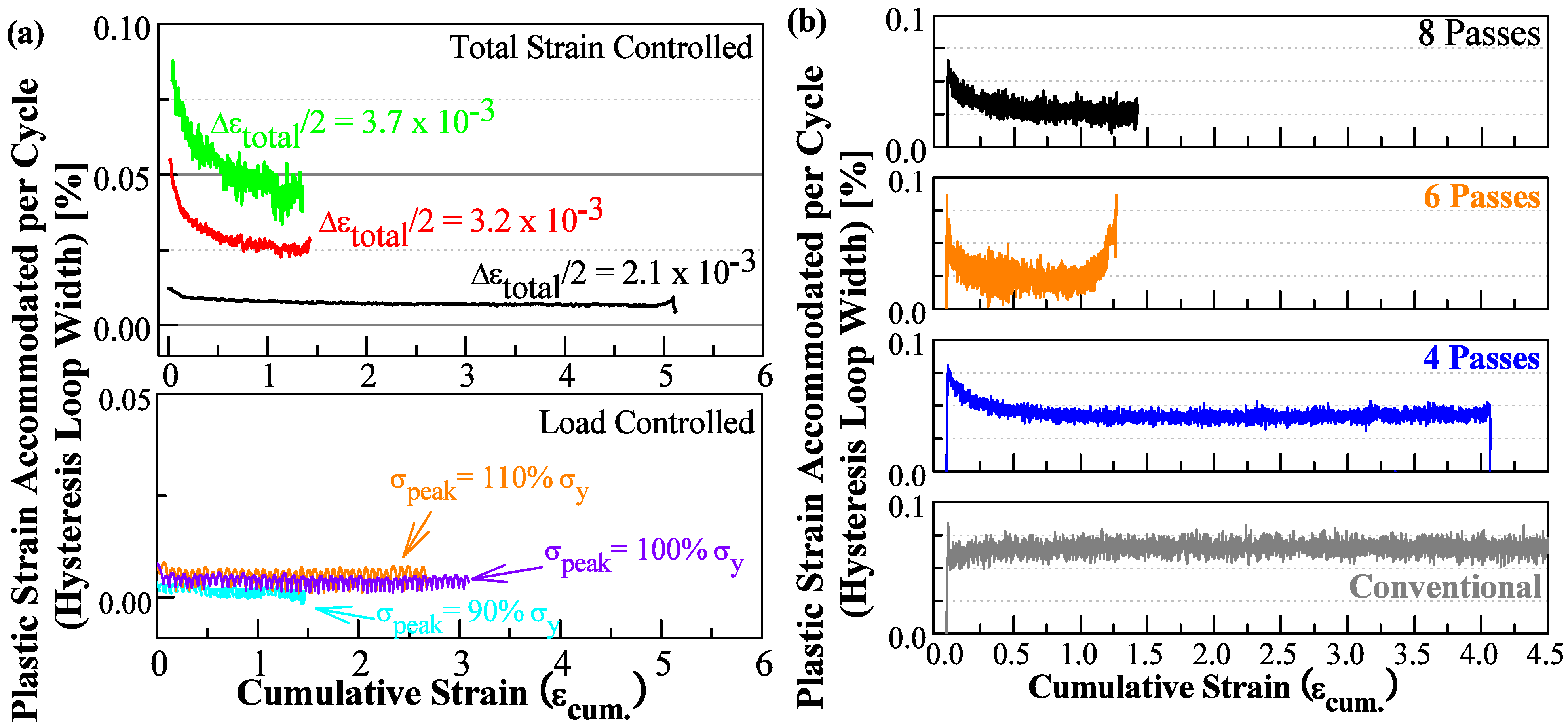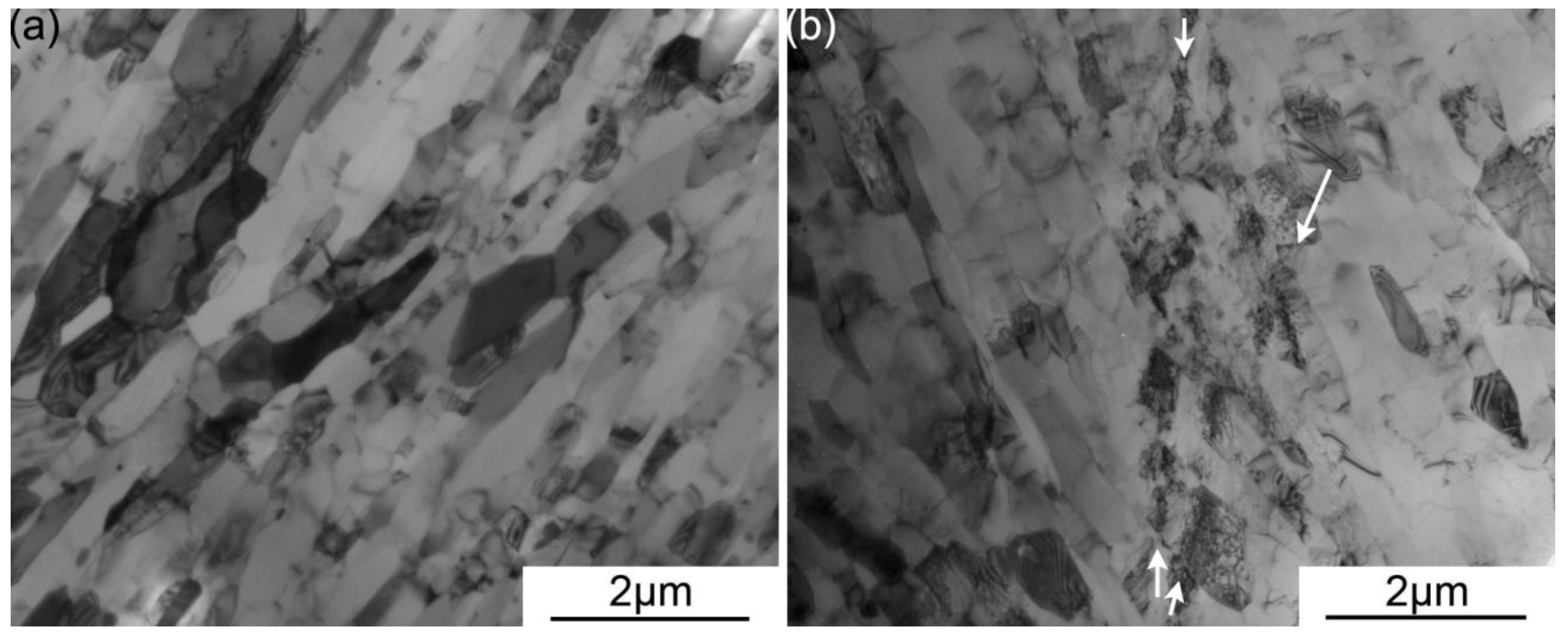Cyclic Deformation of Ultra-Fine Grained Commercial Purity Aluminum Processed by Accumulative Roll-Bonding
Abstract
:1. Introduction
2. Materials and Experiments
3. Results and Discussion
3.1. Initial Microstructure

3.2. Cyclic Deformation Response


3.3. The Activated Micro-Mechanisms


3.4. Correlating the Micro-Mechanism and the Cyclic Deformation Response
4. Conclusions
Acknowledgments
Conflicts of Interest
References
- Saito, Y.; Tsuji, N.; Utsunomiya, H.; Sakai, T.; Hong, R.G. Ultra-fine grained bulk aluminum produced by accumulative roll-bonding (ARB) process. Scr. Mater. 1998, 39, 1221–1227. [Google Scholar] [CrossRef]
- Saito, Y.; Utsunomiya, H.; Tsuji, N.; Sakai, T. Novel ultra-high straining process for bulk materials—Development of the accumulative roll-bonding (ARB) process. Acta Mater. 1999, 47, 579–583. [Google Scholar] [CrossRef]
- Conrad, N.; Jung, K. Effects of grain size from millimeters to nanometers on the flow stress of metals and compounds. J. Electron. Mater. 2006, 35, 857–861. [Google Scholar] [CrossRef]
- Glazov, M.V.; Laird, C. Size effects of dislocation patterning in fatigued metals. Acta Metall. Mater. 1995, 43, 2849–2857. [Google Scholar] [CrossRef]
- May, J.; Amberger, D.; Dinkel, M.; Höppel, H.W.; Göken, M. Monotonic and cyclic deformation behavior of ultrafine-grained aluminium. Mater. Sci. Eng. A 2008, 483–484, 481–484. [Google Scholar] [CrossRef]
- Höppel, H.W.; Xu, C.; Kautz, M.; Barta-Schreiber, N.; Langdon, T.G.; Mughrabi, H. Cyclic Deformation Behaviour and Possibilities for Enhancing the Fatigue Properties of Ultrafine-Grained Metals. In Proceedings of Second International Conference on Nanomaterials by Severe Plastic Deformation, Vienna, Austria, 9–13 December 2002; Zehetbauer, M.J., Valiev, R.Z., Eds.; Wiley-VCH: Weinheim, Germany, 2004; pp. 677–683. [Google Scholar]
- Wong, M.K.; Kao, W.P.; Lui, J.T.; Chang, C.P.; Kao, P.W. Cyclic deformation of ultrafine-grained aluminum. Acta Mater. 2007, 55, 715–725. [Google Scholar] [CrossRef]
- Valiev, R.Z.; Estrin, Y.; Horita, Z.; Langdon, T.G.; Zehetbauer, M.J.; Zhu, Y.T. Producing bulk ultrafine-grained materials by severe plastic deformation. J. Manag. 2006, 58, 33–39. [Google Scholar]
- Kwan, C.C.F.; Wang, Z. On the Cyclic Deformation Response and Microstructural Mechanisms of ECAP and ARB Copper—An Overview. Mater. Sci. Forum 2011, 683, 55–68. [Google Scholar] [CrossRef]
- Huang, X.; Tsuji, N.; Hansen, N.; Minamino, Y. Microstructural evolution during accumulative roll-bonding of commercial purity aluminum. Mater. Sci. Eng. A 2003, 340, 265–271. [Google Scholar] [CrossRef]
- Kim, Y.S.; Lee, T.O.; Shin, D.H. Microstructural Evolution and Mechanical Properties of Ultrafine Grained Commercially Pure 1100 Aluminum Alloy Processed by Accumulative Roll-Bonding (ARB). Mater. Sci. Forum 2004, 449–452, 625–628. [Google Scholar] [CrossRef]
- Kwan, C.; Wang, Z.; Kang, S.B. Mechanical behavior and microstructural evolution upon annealing of the accumulative roll-bonding (ARB) processed Al alloy 1100. Mater. Sci. Eng. A 2008, 480, 148–159. [Google Scholar] [CrossRef]
- Li, B.L.; Tsuji, N.; Kamikawa, N. Microstructure homogeneity in various metallic materials heavily deformed by accumulative roll-bonding. Mater. Sci. Eng. A 2006, 423, 331–342. [Google Scholar] [CrossRef]
- Kwan, C.C.F.; Wang, Z. A Composite Nature of Cyclic Strain Accommodation Mechanisms of Accumulative Roll Bonding (ARB) Processed Cu Sheet Materials. Mater. Sci. Eng. A 2011, 528, 2042–2048. [Google Scholar] [CrossRef]
- Höppel, H.W.; Zhou, Z.M.; Mughrabi, H.; Valiev, R.Z. Microstructural study of the parameters governing coarsening and cyclic softening in fatigued ultrafine-grained copper. Philos. Mag. A 2002, 82, 1781–1794. [Google Scholar] [CrossRef]
- Höppel, H.W.; May, J.; Göken, M. Cyclic Deformation Behaviour and Fatigue Lives of Ultrafine-Grained Aluminium-Magnesium Alloys. Mater. Sci. Forum 2008, 584–586, 840–845. [Google Scholar] [CrossRef]
- Kwan, C.C.F.; Wang, Z. Strain Incompatibility and its influence on the cyclic deformation behaviour of ARB Copper. Philos. Mag. 2013, 93, 1065–1079. [Google Scholar] [CrossRef]
- Furukawa, Y.; Fujii, T.; Onaka, S.; Kato, M. Cyclic Deformation Behavior of Ultra-Fine Grained Copper Produced by Equal Channel Angular Pressing. Mater. Trans. 2009, 50, 70–75. [Google Scholar] [CrossRef]
- Maier, H.J.; Gabor, P.; Gupta, N.; Karaman, I.; Haouaoui, M. Cyclic stress–strain response of ultrafine grained copper. Int. J. Fatigue 2006, 28, 243–250. [Google Scholar] [CrossRef]
- Li, X.-W.; Jiang, Q.-W.; Ying, W.; Wang, Y.; Umakoshi, Y. Stress-Amplitude-Dependent Deformation Characteristics and Microstructures of Cyclically Stressed Ultrafine-Grained Copper. Adv. Eng. Mater. 2008, 10, 720–726. [Google Scholar] [CrossRef]
- Lukáš, P.; Kunz, L.; Svoboda, M. Effect of Low Temperature on Fatigue Life and Cyclic Stress-Strain Response of Ultrafine-Grained Copper. Metall. Mater. Trans. A 2007, 38A, 1910–1915. [Google Scholar] [CrossRef]
- Kunz, L.; Lukáš, P.; Svoboda, M. Fatigue strength, microstructural stability and strain localization in ultrafine-grained copper. Mater. Sci. Eng. A 2006, 424, 97–104. [Google Scholar] [CrossRef]
- Xu, C.Z.; Wang, Q.J.; Zheng, M.S.; Li, J.D.; Huang, M.Q.; Jia, Q.M.; Zhu, J.W.; Kunz, L.; Buksa, M. Fatigue behavior and damage characteristic of ultra-fine grain low-purity copper processed by equal-channel angular pressing (ECAP). Mater. Sci. Eng. A 2008, 475, 249–256. [Google Scholar] [CrossRef]
© 2013 by the authors; licensee MDPI, Basel, Switzerland. This article is an open access article distributed under the terms and conditions of the Creative Commons Attribution license (http://creativecommons.org/licenses/by/3.0/).
Share and Cite
Kwan, C.C.F.; Wang, Z. Cyclic Deformation of Ultra-Fine Grained Commercial Purity Aluminum Processed by Accumulative Roll-Bonding. Materials 2013, 6, 3469-3481. https://doi.org/10.3390/ma6083469
Kwan CCF, Wang Z. Cyclic Deformation of Ultra-Fine Grained Commercial Purity Aluminum Processed by Accumulative Roll-Bonding. Materials. 2013; 6(8):3469-3481. https://doi.org/10.3390/ma6083469
Chicago/Turabian StyleKwan, Charles C.F., and Zhirui Wang. 2013. "Cyclic Deformation of Ultra-Fine Grained Commercial Purity Aluminum Processed by Accumulative Roll-Bonding" Materials 6, no. 8: 3469-3481. https://doi.org/10.3390/ma6083469



